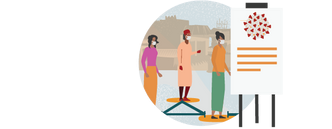How to Practice Risk Communication and Community Engagement
As a community health worker, you are in a strong position to practice RCCE. You live in your community 🏘, know it well, speak the same language, and already have their trust. Practice RCCE by following these steps: active listening, clear communication, community education and inclusive engagement.
Step 1: Active Listening

Active listening helps build mutual respect and trust with your community by showing them that you are there to listen to their concerns. When using active listening, ask open-ended questions and repeat what you hear. Let them do most of the talking🗣. Be supportive of community members as they share their fears, concerns, knowledge 🧠 and beliefs by encouraging them when they speak. Show concern when talking with the community.
Active listening can also help you find out how dangerous people think COVID-19 is to them. It might be based on facts and experiences. Ask questions like "What are you most concerned about right now?". Observe their emotions & tone.
Step 2: Clear Communication

People need short, clear and repeated messages to make good choices in an emergency. Use words they know, keep answers under 2 minutes⏰, pair messages with facts, repeat key messages, start with the most important messages. Add COVID-19 advice when talking to people about other issues they care about (such as social support, malaria, or food security programs).
Misinformation about COVID-19 spreads fast since news comes from many places 📺📻💻📱. Speak with your community about their news source & help them find a reliable one. Engage with community leaders to respond to misinformation. it is important for you & community leaders to be informed about the latest COVID-19 guidelines and facts.
Step 3: Community Education

Educate the community on the risk of COVID-19 with facts and stories about people's lived experiences with COVID-19. 👩🏽🏫👨🏽🏫 Make sure to not give away personal information about those who have had COVID-19 Since COVID-19 is a new disease, people may be afraid and feel the need to blame others emerges. This can lead to stigma against certain populations. Speak to the community about this stigma and help them to understand the facts about COVID-19 to reduce stigma.
Step 4: Inclusive Engagement

Your community is more likely to follow your guidance if they have been listened to, heard, and included in the community's public health response. This is known as inclusive engagement. Invite your community to voice their concerns and include them in public health decisions. Local radio, social media, text and virtual meetings are all tools can help. It is useful to bring people with different COVID-19 experiences together for discussions. Get them to share their experiences and concerns by asking open ended questions🎤.
While virtual meetings are safest, it is not always possible. You can bring people together safely by holding meetings outdoors 🌴. Advise them to wear masks and keep a safe 6ft (2m) apart.
Work with local radio stations and get the community to listen in. Encourage them to ask questions and answer their questions with factual information. Develop short polls or surveys 🗒with your team. Put these on social media to understand people's needs. Ask people to vote ✓on the issues they want to hear about. You can also invite health experts to answer questions.

When creating RCCE messages, test them with the community to find out if they are clear, acceptable and persuasive. Improve your messages based on what the community tells you. Try different ways to engage the community such as community meetings, in church or other settings. Always use kind questions and listen actively.
When implementing RCCE, make sure to include the most marginalized and vulnerable populations, i.e. women, children/adolescents, seniors, refugees, gender minorities, people in poverty and people with disabilities. Make a strong effort to reach them 📣.

Include women🚺 by inviting them to planning meetings and involve woman leaders. Tailor messages for women that are gender sensitive. Share information with women about where to find help for childcare, pregnancy services, services for those experiencing violence and transportation to the nearest health facility. Share advice on hygiene practices and how to prevent the spread of COVID-19.

Include children and adolescents 🚸 in discussions. Tailor advice that is easy for them to understand. Give parents and caregivers resources for mental health.

To include people with disabilities and special needs ♿️, make advice accessible to everyone. Where possible share materials in braille and signed videos etc. Also involve their caregivers and advocates.

Include refugees and migrants by translating messages into their language and tailoring them with their beliefs and practices. Involve NGOs that can reach them.

Include sexual and gender minorities by discussing their needs and concerns. Involve LGBTQ networks.

Use many channels to reach people living in poverty. Give support and resources. Provide messages about preventing COVID-19 in slums, camps and shelters.

Include the elderly 👵in discussions. Tailor messages for long-term care facilities. Involve caregivers and educate them on the higher risk of COVID-19 in the elderly.


